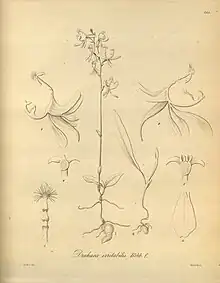| Clubbed elbow orchid | |
|---|---|
 | |
| Illustration of Drakaea irritabilis from Nathaniel Wallich's Plantae Asiaticae Rariores | |
| Scientific classification | |
| Kingdom: | Plantae |
| Clade: | Tracheophytes |
| Clade: | Angiosperms |
| Clade: | Monocots |
| Order: | Asparagales |
| Family: | Orchidaceae |
| Subfamily: | Orchidoideae |
| Tribe: | Diurideae |
| Genus: | Arthrochilus |
| Species: | A. irritabilis |
| Binomial name | |
| Arthrochilus irritabilis | |
| Synonyms[1] | |
Arthrochilus irritabilis, commonly known as clubbed elbow orchid, is a flowering plant in the orchid family (Orchidaceae) and is endemic to Queensland. It has up to five leaves and up to thirty light greenish or reddish, insect-like flower with reddish, hair-like glands on its labellum. There is a single record of this species from Papua New Guinea.
Description
Arthrochilus irritabilis is a terrestrial, perennial, deciduous, sympodial herb with an underground tuber which produces daughter tubers on the end of root-like stolons. It has between three and five narrow lance-shaped, bluish green leaves 30–80 mm (1–3 in) long and 8–14 mm (0.3–0.6 in) wide on side growth at the base of the flowering stem. Between five and thirty light greenish or reddish insect-like flowers, 10–14 mm (0.4–0.6 in) long are borne on a thin, wiry, green to reddish flowering stem 120–350 mm (5–10 in) tall. The dorsal is 8–11 mm (0.3–0.4 in) long, about 2 mm (0.08 in) wide, folded lengthwise near the tip and directed more or less downwards. The lateral sepals are oblong, curved, 5–7 mm (0.2–0.3 in) long and about 1 mm (0.04 in) wide. The petals are linear, 5–7 mm (0.2–0.3 in) long and about 1 mm (0.04 in) wide. The lateral sepals and petals all turn downwards towards the ovary. The labellum is about 5 mm (0.2 in) long, 1 mm (0.04 in) wide with a reddish base. The labellum callus is insect-like, about 2.5 mm (0.1 in) long with its central area crowded with hair-like, reddish or purplish glands. The tip of the callus is about 1 mm (0.04 in) long and covered with shiny, blackish glands. The column is curved, 7–8 mm (0.28–0.31 in) long with two pairs of curved triangular wings. Flowering occurs from November to February.[2][3][4]
Taxonomy and naming
Arthrochilus irritabilis was first formally described in 1858 by Ferdinand von Mueller and the description was published in Fragmenta phytographiae Australiae from a specimen collected "from wooded hills near Moreton Bay".[5][6] The specific epithet (irritabilis) is a Latin word meaning "easily excited".[7]
Distribution and habitat
The clubbed elbow orchid grows in woodland, forest and heath, sometimes forming large colonies. It is widespread and common between Ingham and Brisbane.[2][3] There is a single record from Papua New Guinea.[4]
Ecology
As with other Arthrochilus orchids, A. irritabilis is pollinated by males thynnid wasps of the genus Arthrothynnus although the species involved is not known. It also reproduces asexually by producing new tubers.[8]
References
- 1 2 "Arthrochilus irritabilis". World Checklist of Selected Plant Families (WCSP). Royal Botanic Gardens, Kew.
- 1 2 Jones, David L. (2006). A complete guide to native orchids of Australia including the island territories. Frenchs Forest, N.S.W.: New Holland. p. 159. ISBN 1877069124.
- 1 2 D.L.Jones; T.Hopley; S.M.Duffy (2010). "Factsheet - Arthrochilus irritabilis". Australian Tropical Rainforest Orchids. Centre for Australian National Biodiversity Research (CANBR), Australian Government. Retrieved 31 May 2021.
- 1 2 "Arthrochilus irritabilis". Orchids of New Guinea. Retrieved 28 April 2018.
- ↑ "Arthrochilus irritabilis". APNI. Retrieved 28 April 2018.
- ↑ von Mueller, Ferdinand (1858). Fragmenta phytographiae Australiae. Melbourne: Government Printer. p. 42. Retrieved 28 April 2018.
- ↑ Brown, Roland Wilbur (1956). The Composition of Scientific Words. Washington, D.C.: Smithsonian Institution Press. p. 103.
- ↑ "Arthrochilus". Australian National Botanic Garden. Retrieved 26 April 2018.